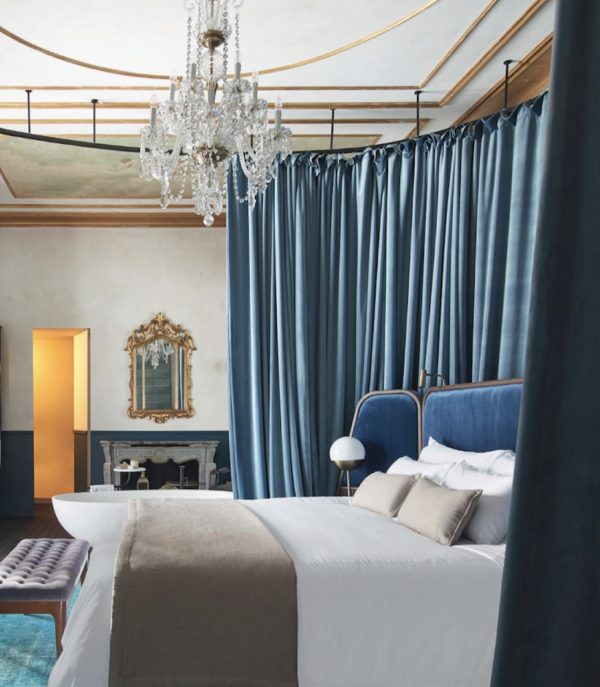A home should be a refuge – a calm, warm, inviting place to unwind at the end of the day. But all too often it falls short of that ideal. The clutter piles up, the sofa gets stained, the lighting seems cold, the paint colours aren’t quite what we expected and the accessories don’t work together to form a cohesive whole. By following a few simple steps, however, it’s possible to calm the chaos, take control and make any house or apartment a more welcoming home. Here’s how to bring joy to your space.
SET GOALS
You may need to bring in some new items to make your home more controlled, but before you start to purge, it’s important to deal with what you already have and set goals for what you want to achieve.
People have varying ambitions for their homes, and differences in taste. You might desire a Zen-inspired retreat, a gallery-like interior that showcases an art collection, or a pillowy palace full of soft surfaces. Each of these goals will require different types of objects, in different quantities. (If you have a partner or roommates, you will also need to work out these goals with them before you proceed. If you strongly disagree, think compromise).
The first step of organising has nothing to do with things. It’s about clarifying who you are and how you want to live.
Consider whether you prefer spaces that feel invigorating or calming, as well as the specific activities you want your home to support, such as cooking, exercising, writing, entertaining, or reading.
Look back at spaces that made you feel unhappy, and ones that made you feel happy, and try to understand why they did. If, for instance, your parents’ collection of antique Chippendale furniture made you squirm, but a minimalist Japanese hotel made you feel immediately relaxed, those things should inform your design decisions.
You have to filter out stale ideas that your mother or aunt gave you about how you should live, or what you should have in your space, “Does it have to do with you or not?”

Consider whether you prefer spaces that feel invigorating or calming. UK Image via Elle Decoration.
EDIT WITH EASE
Editing belongings and removing clutter from a home can seem so overwhelming that some people simply put it off forever. People get stuck. But the trick to moving forward, is to start by eliminating the things you already know you don’t need or want. Read more, ‘The Ultimate Decluttering Guide.’
Always do the easiest things first, noting that most people have piles of old clothing, luggage, magazines, toys, worn bedding and tchotchkes just waiting to be eliminated. With the editing process, you want to get as much out as quickly as possible to help change the energy of the space.
Put objects you’re unsure about aside for the time being, and don’t let them derail the cleanout. As you see the space improving, you’ll probably have a better understanding about what to do with the trickier things.
How a room is illuminated can have a significant impact on your mood.
WATCH THE COLOUR TEMPERATURE
For soothing light with a golden glow, look for fixtures and bulbs that offer a warm colour temperature. Don’t go too high, or the light will begin to look bluish-white — good for an office or warehouse, but rarely desirable at home. Read more, ‘The Essential Guide to Lighting.’
In the age of LEDs, however, not all light sources are equal. Some may appear more yellow than others. Some may hold a constant colour temperature as they are dimmed, while others will get warmer, like a traditional incandescent bulb.
Read specifications and packaging carefully, and test the different fixtures and bulbs together in the rooms where you plan to use them. Do all the colour temperatures work together, and dim together?
If one fixture gives off a golden glow while another provides bluish-white light, the overall look will be unsettling. Even though they may come from different manufacturers, the goal is to have all the fixtures appear as though they’re on the same team.
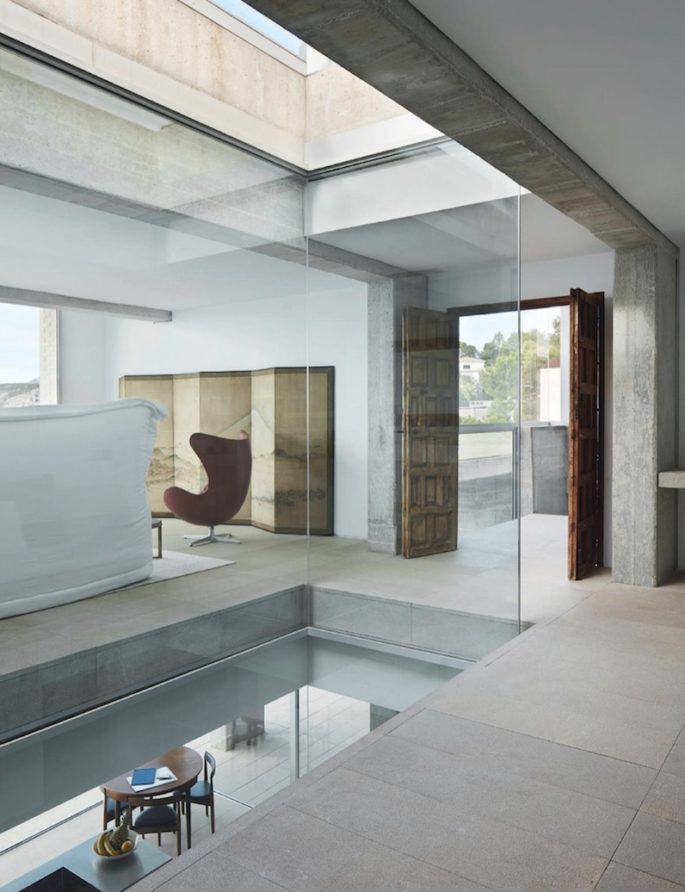
Manage the sun: Sunlight helps almost any room look its best, but it’s possible to have too much of a good thing. Image via UK Elle Decoration.
LAYER THE LIGHT
Don’t expect a single light fixture on the ceiling to create an environment that feels welcoming. Designers typically install many different types of lighting, at three key levels — with ceiling lamps, table lamps, and floor lamps — to highlight different parts of a room while offering pleasing ambient light that can be adjusted for different functions and times of the day.
Layers of light are very important, so there are different focal points. We have overhead lighting in our country house, but we tend not to use it at night, as it can feel like a classroom. We’ll turn on wall lamps, table lamps and add candles. That softens the room and makes the space feel calmer.
Picture lights above key artworks, will not only highlight some of your favourite things, but also offer a warm, nightlight-style glow.
Think of the room as a stage – there are things you want to accentuate and other areas you want to fade away, depending on the time of day and your activities. Resist the impulse to indiscriminately flood a room with light, unless you’re doing the housecleaning because everything just gets washed out, and it’s certainly not flattering.
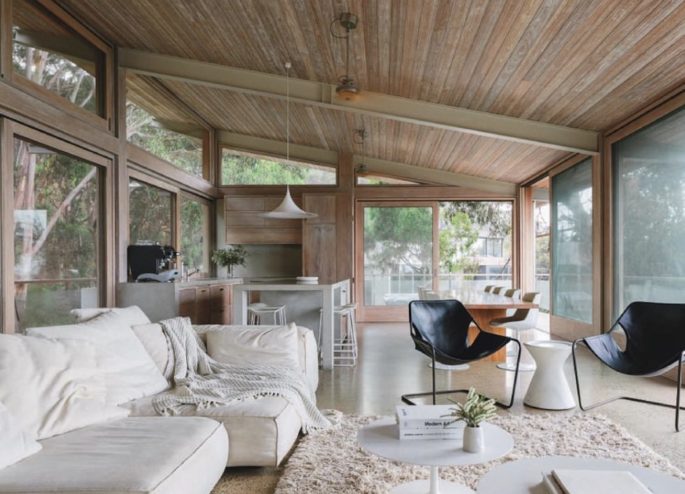
Image via Elle Decoration UK
TAKE CONTROL
Interior designers frequently recommend having every light fixture on a dimmer, so that light levels can be adjusted to perfection. While that advice may not be as critical for small and low-powered lights, such as picture lights, having the primary lights in a room on dimmers can be a big help when trying to achieve your desired mood.
MANAGE THE SUN
Sunlight helps almost any room look its best, but it’s possible to have too much of a good thing. Direct natural light pouring through windows can be almost blinding, while also fading artwork and textiles. And, if the windows look out to neighbouring apartments or homes, uncovered windows may make your space feel uncomfortably exposed.
To control natural light levels, designers frequently install two layers of window coverings over each opening – a light layer, such as a solar shade or sheer fabric, to filter sunlight and provide a degree of privacy, and a heavier layer, often with a blackout material or lining, which can make the room truly dark.
We recommend Roman shades for their sharp-edged and clean tailoring especially in a gauze fabric that cuts the harsh sun that allows you to still enjoy the light without it overwhelming the room. Then, in rooms where absolute darkness is required, like bedrooms, adds blackout roller shades behind the Roman shade.
This strategy can also be reversed by installing curtains with a blackout lining on a track or rod in front of the window and adding a light-filtering shade within the window frame behind them.
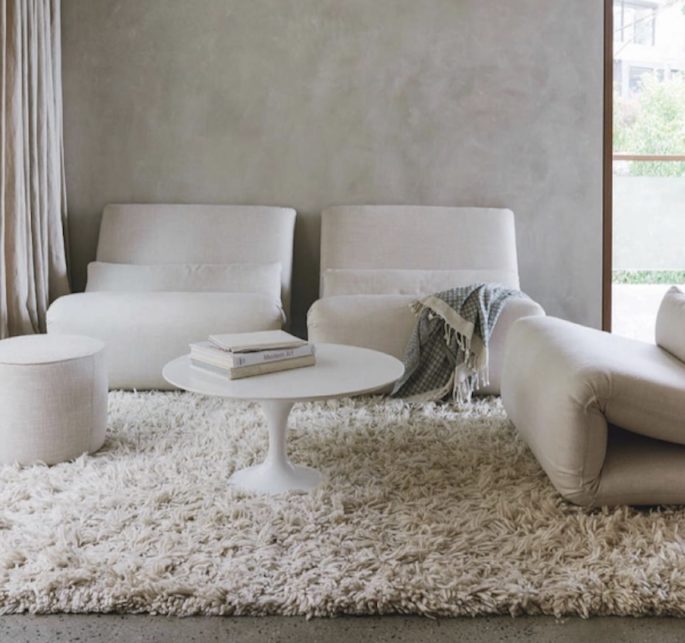
Use light colours for a serene home that don’t demand attention. And, for a serene home, comfort is at least as important as aesthetics. Image via UK Elle Decoration.
USE LIGHT PAINT COLOURS
Personal preference always counts when choosing paint colours, but for the common areas of a serene home, a good rule of thumb is to choose subdued colours that don’t demand attention. Read more, ‘The 20 Best Paint Colours According to Dulux.’
If you really want to make a room calm, keep it fairly light toned and all the parts and pieces of that room in the same colour family will create a soothing visual experience. Many people react well to “really quiet, soft greys,” while others prefer very pale blues. Colours that feel almost shadowy.
We like paint that looks almost white when it’s sunny, and as the day progresses, the colour changes and becomes stronger. When you look at the fan deck of colours, go to the lightest tonalities. It’s about having just a hint of a colour.
The lighter the paint colour, the more it is associated with calmness and relaxation.
According to many studies blue and green, specifically, are also associated with feeling calm and relaxed. When people look at these colours, their heart rate physically lowers, creating a feeling of serenity and relaxation, Mindbodygreen reports. Read more, ‘Paint Mistakes: The 9 Colour Mistakes You Should Never Make.’
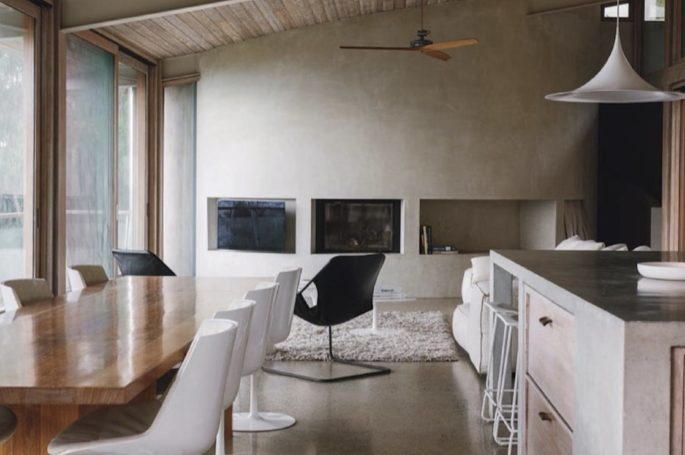
If you really want to make a room calm, keep it fairly light toned and all the parts and pieces of that room in the same colour family to create a soothing visual experience. Image via UK Elle Decoration.
AVOID SHINY SHEENS
For walls with colour that almost appears to dissolve in space, we recommend a flat or matte sheen (two terms that are used interchangeably for the same finish) for walls, and a slightly shinier, more durable eggshell or satin sheen on trim.
For those who wants a Zen retreat, instead of changing the colour between the woodwork and the walls, stick to the same shade for both surfaces, but change the finish just a little.
Paint the ceiling the same colour in a flat sheen, or choose a shade that is slightly lighter than the walls.
GO DARK IN SMALLER AREAS
Very dark paint can be highly effective in creating a cocooning environment in secondary rooms that are used primarily at night, such as bedrooms and media rooms. We’ve done it ourselves. A dark, dark navy blue feels very calming.”
A lot of people are surprised by how much they like a room like that. We know people who worry that it will feel too small. Often, the opposite is true. You get this cocoon or nest feeling, and people want to use the room more.
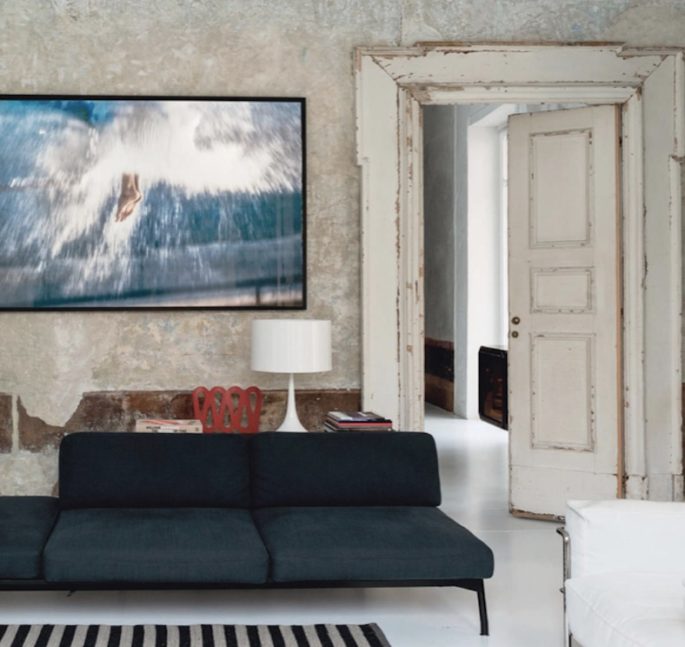
Matte plasters with integral colours can give walls an earthy, hazy appearance which have a little texture and a stone-like feel, which is very calming and serene. Image via UK Elle Decoration.
USE WILDER COLOURS AS HIDDEN SURPRISES
Designing a serene home doesn’t mean you have to give up your favourite bright, saturated colours. Just be choosy about where you use them.
You can use your favourite colours as surprises inside wardrobes, cupboards and drawers. If you love shocking pink – even though your bedroom is designed to look peaceful, you can design a wardrobe that opens to a shocking pink interior. Or acid yellow Or kitchen drawers that are flaming, orangey red,
SEEK OUT TEXTURAL ALTERNATIVES
Paint is the most common and least expensive way to finish walls, but a number of alternatives can add desirable textures. Specialty matte plasters with integral colours can give walls an earthy, hazy appearance which have a little texture and a stone-like feel, which is very calming and serene. The walls at our own country house have walls like this, and it is a very peaceful place to live.
While highly patterned wallpaper may not be ideal, different types of grasscloth from Phillip Jeffries to add a natural, calming touch to bedrooms. Read more, ‘Wallpaper: The Ultimate Guide to Transforming Your Walls.’ They add texture to the walls, but don’t seem jarring as you walk into the space, and they come in all colours, including creams, pale blues, greens and soft greys.
Focus on pleasing the senses rather than chasing the latest fashions.

Don’t just buy furniture and fixtures online based on how good they look; go see the pieces in person and try them out. Image via UK Elle Decoration.
PRIORITISE COMFORT
It may seem obvious, but for a serene home, comfort is at least as important as aesthetics. Don’t just buy furniture online based on how it looks; go see the pieces in person and try them out. Do a flop test. Stand in front of the sofa, let yourself go, and flop onto it. Does it have open arms for you?”
Different people like different levels of cushioning. For instance, we like to have cushions that are soft. We hate ones that bounce back and throw us out of a seat. However, some people may desire more support.
If the sofa doesn’t make you want to curl up for a siesta right there in the showroom, move on until you find one that does.
USE OUTDOOR FABRICS INDOORS
Having to worry about guests spilling drinks on your new sofa or armchairs is anything but serene. For worry-free upholstery, choose an outdoor fabric designed to resist stains and spills. Companies such as Sunbrella, and Janus et Cie are now making so many different options, in so many aesthetically pleasing textures, that most people can no longer tell the difference from indoor-only fabrics.
They have velvets, tweeds, chenilles that are routinely used indoors by top international designers. You can pour anything on them, they won’t fade in the sun, you can wash them with soap and water.
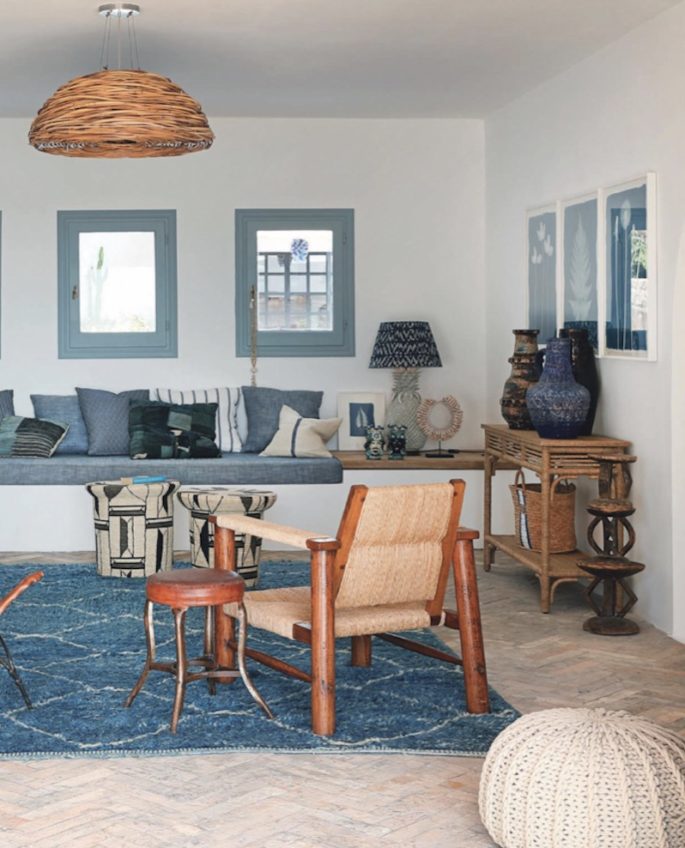
You want your rooms to have different materials, different weaves, different levels of softness, and maybe something like leather that has a smooth finish, to make the space interesting but not visually overwhelming. Image via UK Elle Decoration.
FOCUS ON TEXTURE
Soft accessories, such as cushions, throws and rugs, typically offer opportunities to bring in eye-catching colours and patterns capable of dazzling guests. For a more serene space, however, focus on adding a range of textures that feel good to touch instead.
You want the room to have different materials, different weaves, different levels of softness, and maybe something like leather that has a smooth finish, to make the space interesting but not visually overwhelming.
Do you dread getting out of bed in the morning? Perhaps stepping onto luxuriously soft wool or silk rug would make all the difference.
Handmade products by international artisans can also work particularly well. Bring in an ethnic weave and multinational pieces collected from Africa, Indonesia, China or India.
When the wastebasket in a bathroom or home office is made from unsightly plastic or metal, another one of her favourite tricks is to hide it within a larger handmade wood or ceramic vessel. “It’s an art piece that’s a container of possibility, such as pieces from Orient House, orienthouse.com.au
CONSIDER SOUND
Beyond what things look like, and how they function, pay attention to how they sound.
If your bedroom door hinges squeak, adjust and lubricate them to avoid a daily annoyance. If footsteps on the hardwood floor outside the bedroom are disruptive at night, put down a runner with a rug pad. If your pots and pans annoyingly clank together every time you remove one from the drawer, install dividers.
The goal is to eliminate, or at least soften, audible disturbances.
At the same time, look for opportunities to add sounds you find pleasing. If you love music, install wireless speakers in every room, like those from Sonos, for whole-home audio. If you enjoy the burbling sound of running water, consider a small water feature.
DON’T FORGET SCENT
Home fragrances aren’t for everyone, but they can serve as a powerful mood booster if you find scents you like. (There’s a reason that hotels and high-end stores scent the air. There are a multitude of ways to bring preferred scents into a space, including candles, sprays, reed diffusers, and incense burners. Read more, ‘5 Scents for Every Room of the House.’
Combined with good lighting, and pleasing colours and textures, a favourite scent may be just the thing to complete a relaxing environment that encourages winding down at the end of the day.
Every evening, I turn the table lamps on, light a sandalwood candle, put the fire on – If I’m not addressing all the senses, the house -and everyone in it – are not going to be feeling as good.

Image via UK Elle Decoration.
This story is an excerpt that appeared in New York Times.

